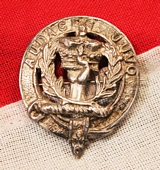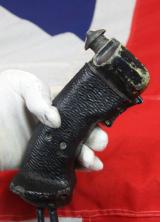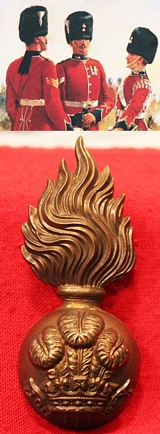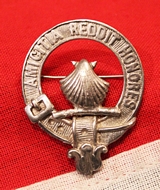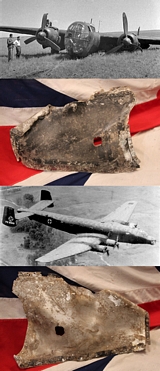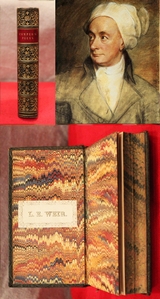Scottish Silver Buchanen 'Audaces Juvo' Clan Glengarry Badge 1930's
Not hallmarked silver. Clan Buchanan Audaces Juvo I Help the Brave. Is an armigerous Scottish clan whose origins are said to lie in the 1225 grant of lands on the eastern shore of Loch Lomond to clergyman Sir Absalon of Buchanan by the Earl of Lennox. A Dexter Hand Holding Up A Ducal Cap Proper., Tufted On The Top With A Rose Gu., All Within Two Laurel-Branches In Orle Vert. Traditionally, the Glengarry bonnet is said to have first appeared as the head dress of the Glengarry Fencibles when they were formed in 1794 by Alexander Ranaldson MacDonell of Glengarry, of Clan MacDonell of Glengarry. MacDonell, therefore, is sometimes said to have invented the glengarry - but it is not clear whether early pictures of civilians or fencible infantry show a true glengarry, capable of being folded flat, or the standard military bonnet of the period merely 'cocked' into a more 'fore-and-aft' shape. The first use of the classic, military glengarry may not have been until 1841, when it is said to have been introduced for the pipers of the 79th Foot by the commanding officer, Lieutenant Colonel Lauderdale Maule.
It was only in the 1850s that the glengarry became characteristic undress headgear of the Scottish regiments of the British Army. By 1860, the glengarry without a diced border and usually with a feather had been adopted by pipers in all regiments except the 42nd (Black Watch), whose pipers wore the full dress feather bonnet. In 1914, all Scottish infantry regiments were wearing dark blue glengarries in non-ceremonial orders of dress, except for the Cameronians (Scottish Rifles) who wore them in rifle green, and the Scots Guards, who wore peaked forage caps or khaki service dress caps. read more
65.00 GBP
A Super & Rare US Civil War Souvenir, An Original US Cavalry Gallagher Carbine Stock.
Ideal for the collector of rare Civil War arms that is not necessarily inclined to buy a full rifle for the several thousands of pounds it would cost, or, for an owner of a Gallagher that needs a replacement stock. If needed as such, it would normally be simply impossible to find an original example, in such wonderful condition, ever available on the collector market.
Fine walnut stock, with all steel furniture including the steel hinged patchbox, steel butt plate and side screw mounts. In superb condition and three figure serial number, 257 [repeated], stamped on the inner steel patch box lid. On the underside are several crudely carved notches, traditionally, are supposed to represent enemy soldiers that have been successfully 'introduced' to the horse soldier's shooting prowess.
The Gallager Carbine was conceived in 1860 by Mahlon J. Gallager. Receiving his patent on the 17th of July 1860, Gallager submitted his design to military trials. The design was approved and Federal forces issued a contract for Richardson and Overman of Philadelphia to produce the carbine. This contract resulted in 22,728 Gallagers to be produced before the end of the American Civil War, which was more than some other breechloading rifles (such as the Joslyn Rifle or Starr Carbine) but no where near as many as the Springfield Model 1861 rifled musket (whose production passed over 1,000,000 during the conflict).
The Gallager Carbine had a rather unusual breechloading design, using a modified version of the more typical lever-action mechanism to open the breech. As was the trend at the time, the lever effectively formed the trigger guard , and when pulled downwards slid the barrel forwards, before tiliting downwards. This then allowed the user to remove the spent cartridge (most commonly with a knife) and insert the new cartridge. The barrel was then pushed back into place, then locked when the lever was put into its upwards position, ready for firing.
Initially the Gallager was manufactured utilising a percussion lock mechanism, largely due to the fact that the quickest (and cheapest) cartridges to produce at the time were made of paper. This mechanism was not modified on later models, despite the use of metallic cartridges. Other features of the Gallager included iron fittings (ie the buttplate of the stock and patchbox) and a lack of a forestock.
The lack of a forestock is not that much of a suprise, however, as the shorter stock meant that the barrel could tilt once it had moved forwards (otherwise the barrel would have to have been allowed to move further to allow the user to load the new cartridge). Furthermore, because there was a lack of a forestock, the Gallager also lacked any form of barrel bands and also lacked the ability to have a bayonet mounted to it. The barrel itself had six grooves forming the rifling pattern and measured 22.25in (0.57m) in length.
Photo in the gallery of a US Civil War Horse Soldier with his carbine, sabre and revolver, also a photo of the complete Civil War Gallaghar Carbine in the Smithsonian read more
450.00 GBP
A Very Interesting Antique Civil War Period Belgian 1850's Colt Navy Copy Patent Infringement Revolver
An Antique Engraved Period Belgian copy Civil War Colt, Model 1851 Navy Percussion Revolver circa, 1850's, SN#.3568 , 6 1/8", .35 cal. octagon steel barrel stamped with (2) inspection/proof marks, a small "CROWN" over "R" and a small on the right side of the barrel just in front of the barrel wedge, with barrel stamped 'Cap System by Americain' and twin cross keys on the top flat with light to moderate pitting
Frame marked; sic "PATEND SYSTEM" on the right side. 5-Shot round cylinder with approx. 20% of the scene remaining possibly of Native American teepees. Two piece grip scales, main steel components are serial numbered and match, the cylinder, trigger, and cylinder ratchet pawl are all numbered 26. The action needs mechanical attention in that the trigger, and cylinder ratchet pawl, are not fitted in place. Several screws [around 5] are missing in order to fully assemble it. A jolly decent example of one of the many gun-makers attempting to infringe on Samuel Colt's Navy revolver of 1851.
Just some rudimentary engineering skills required to fully re-assemble and make good.
SOME COLT HISTORY: Samuel Colt had a difficult time when he patented the PATTERSON revolver in the late 1830's and did not really achieve success until he received a purchase order of 1000 newly designed massive .44 caliber "Walker" revolvers to arm Texas Ranger Captain Samuel Hamilton Walker for the Mexican-American War (1846-1848). The "Walker" Colts were delivered in 1847 which Captain Walker carried a pair into battle and was killed in action by a sniper's bullet while leading a cavalry charge at the Battle of Huamantla on October 9th, 1847.
Samuel Colts business started to flourish attracting world recognition upon the creation of the .31 caliber model 1849 "Pocket" revolver but then skyrocketed when the .36 caliber model 1851 "Navy" revolver took the scene. Colt had the proper patents both domestic and foreign to protect his designs but that did not stop competitors from copying his patterns. Colt was able to establish several license agreement's which includes having a representative at the Belgium proof house to monitor and charge the competitors a fee to have their copies inspected and approved. If approved, the top of the barrel was stamped "COLT BREVETE" indicating that the copy was of good quality and could be sold. However, many foreign gun makers would avoid the proof house and inspection and made their own fake proof marks and Colt Brevete stamps. read more
985.00 GBP
A Fabulous Piece of British Armed Forces Helicopter Aeronautica. A Souvenir of the Falklands War, A Westland Wessex Helicopter Cyclic Control Grip With Wiring
We acquired this from a former SF Falklands War veteran, who brought it back from the South Atlantic. It came from a Westland Wessex helicopter that had, apparently, somewhat, come a cropper. Of course we have no idea which chopper this control grip came from, and it certainly couldn't likely have come from a maritime loss, but none the less it is a great original part of the Westland Wessex, in pretty good condition, considering its circumstances of acquisition. It bears a serial number and its wiring portion.
Around 55 Westland Wessex HU.5s participated in the Falklands War, fighting in the South Atlantic in 1982. On 21 May 1982, 845 Squadron's Wessex HU.5s supported British landings on East Falkland. The type was heavily used throughout the conflict for the transportation and insertion of British special forces, including members of the Special Air Service (SAS) and the Special Boat Service (SBS). A total of nine Wessex (eight HU.5s and one HAS.3) were lost during the Falklands campaign. Two HU.5s of 845 Squadron crashed on the Fortuna Glacier in South Georgia during an attempt to extract members of the SAS during a snow storm, six of 848 Squadron's Wessex HU.5s were lost when the container ship Atlantic Conveyor was sunk and the HAS.3 aboard HMS Glamorgan was destroyed when the ship was struck by an Exocet missile.
The Falklands War was a ten-week undeclared war between Argentina and the United Kingdom in 1982 over two British dependent territories in the South Atlantic: the Falkland Islands and its territorial dependency, South Georgia and the South Sandwich Islands.
The conflict began on 2 April, when Argentina invaded and occupied the Falkland Islands, followed by the invasion of South Georgia the next day. On 5 April, the British government dispatched a naval task force to engage the Argentine Navy and Air Force before making an amphibious assault on the islands. The conflict lasted 74 days and ended with an Argentine surrender on 14 June, returning the islands to British control. In total, 649 Argentine military personnel, 255 British military personnel, and three Falkland Islanders were killed during the hostilities.
The conflict was a major episode in the protracted dispute over the territories' sovereignty. Argentina asserted (and maintains) that the islands are Argentine territory, and the Argentine government thus characterised its military action as the reclamation of its own territory. The British government regarded the action as an invasion of a territory that had been a Crown colony since 1841. Falkland Islanders, who have inhabited the islands since the early 19th century, are predominantly descendants of British settlers, and strongly favour British sovereignty. Neither state officially declared war, although both governments declared the islands a war zone.
The conflict has had a strong effect in both countries and has been the subject of various books, articles, films, and songs. Patriotic sentiment ran high in Argentina, but the unfavourable outcome prompted large protests against the ruling military government, hastening its downfall and the democratisation of the country. In the United Kingdom, the Conservative government, bolstered by the successful outcome, was re-elected with an increased majority the following year. The cultural and political effect of the conflict has been less in the UK than in Argentina, where it has remained a common topic for discussion.
Diplomatic relations between the United Kingdom and Argentina were restored in 1989 following a meeting in Madrid, at which the two governments issued a joint statement. No change in either country's position regarding the sovereignty of the Falkland Islands was made explicit. In 1994, Argentina adopted a new constitution, which declared the Falkland Islands as part of one of its provinces by law. However, the islands continue to operate as a self-governing British Overseas Territory read more
325.00 GBP
A Very Good Fur Cap Plume Badge Of The Royal Welch Fusiliers
An original metal, other ranks Fur Cap Grenade of The Royal Welch Fusiliers worn 1888 - 1908. In excellent condition and complete with its 2 long rear loops. In the nineteenth century, the regiment took part in the Crimean War, the Second Opium War, the Indian Mutiny and the Third Anglo-Burmese War. The regiment was not fundamentally affected by the Cardwell Reforms of the 1870s, which gave it a depot at Hightown Barracks in Wrexham from 1873, or by the Childers reforms of 1881 ? as it already possessed two battalions, there was no need for it to amalgamate with another regiment. Under the reforms, the regiment became The Royal Welch Fusiliers on 1 July 1881. The regiment went on to serve in the Second Boer War of 1899-1902. read more
110.00 GBP
Original Vintage Scottish Pringle Clan Bonnet Badge, with Latin Clan Motto 'Amicitia Reddit Honores' With Clam Shell Crest Hallmarked Edinburgh Silver
The motto reads 'Friendship Gives Honour'. In the 14th century the family were close allies of the Earls of Douglas, to whom they were squires, and about the end of that era they are first defined as Hoppringle of that Ilk, holding the lands of Earlside in Lauderdale. Descendants were much in evidence at the Courts of James IV and V, at least two being trumpeters in the tail of James IV and one falling at his side at Flodden in 1513. For 100 years, from about 1489, a succession of Pringle ladies, usually younger daughters, were Prioresses of the Convent at Coldstream. The association of Pringles with the woollen industry may be traced to 1540 when one of their name held the responsibility for overseeing the shearing, storage and transportation of the wool from the King's sheep. In 1592 various Pringles appeared before the King, with other Border lairds, giving an oath to faithfully serve the Wardens of the East and Middle Marches, and evidence of their extended land-holdings is shown by no less than six cadet families standing surety, one for the other, in keeping the peace. Five years later, Pringle of that Ilk and Pringle of Smailholm subscribed to a Bond of Manrent, taking it upon themselves the burden of ensuring the good behaviour of Pringles in general. The last Pringle of that Ilk died in 1737, after which the principal family became the Pringles of Stitchill, the lands of which were acquired c.1630. Of this latter house, Sir Robert was created a Baronet of Nova Scotia in 1683 and, although the lands have now been sold, the Baronetcy has survived into the 21st century, the current baronet title being.
Sir Norman Murray Archibald MacGregor Pringle of that Ilk and Stichill, 10th Baronet
Several Pringles have become Senators of the College of Justice in Scotland, which comes with the title and rank of Lord of Session.
On 6 June 1718 Sir Walter Pringle became Lord Newhall.
On 1 July 1729 John Pringle of The Haining became Lord Haining.
On 20 November 1754 Robert Pringle became Lord Edgefield.
On 14 June 1757 Andrew Pringle became Lord Alemore. read more
165.00 GBP
A Large Original Recovered Piece of a WW2 German Crashed Bomber's Alloy Wing Top Panel
Taken from a crashed German bomber, with original wing-top paint. Numerous rivet holes and rivet heads present. Typical german wing-top paint for a bomber aircraft. There is a partial printed word on the underside and with dilligent research it should be traceable to a specific bomber type.
Over the years we have had some amazing aeronautical archeological finds, and most have been identified by their approved, and gov. registered recoverers, yet this fine piece was placed in storage, and it’s plane I’d was mislaid, so the research for it has to start again if it is needed, but the price reflects that, and it may well reveal wonderful results.
14.75 inches x 22.0 inches. Just over 3.5 pounds weight. read more
395.00 GBP
A Very Rare Original,1930's Aeronautical Collection of Wide, Wool Felt, Sleeve Patches for Early Airships & Aeroplanes
Shoulder sleeve insignia. For the Farman Biplane USA, Astra Monoplane, Curtis Biplane USA, Delagrange Biplane, Ferber Biplane, Bleriot Monoplane, French Military Dirigible, Wright Biplane, Reid-Curtis Flying Boat USA, and the Mengin Monoplane.
In the early 20th century US military the 81st Infantry Division "Wildcat" is generally agreed to have been first U.S. Army unit authorised shoulder sleeve insignia or SSI. In 1918, during World War I, the 81st Division sailed for France after training at Fort Jackson, South Carolina. On their left shoulder the men of the division wore an olive drab felt patch with the silhouette of a wildcat - after Wildcat Creek, a stream that flows through Fort Jackson. When men of the other fighting divisions challenged the right of 81st soldiers to wear the patch, General John J. Pershing ruled that the 81st could keep this distinctive insignia. He also suggested that other divisions adopt shoulder patches of their own. This patch was officially adopted by the U.S. Army on October 19, 1918. The first patches were often primitive but by World War II, the manufacture was regulated.
By World War II, all army groups, field armies, corps, and divisions, as well as all major Army commands, had unique SSI. These SSI would often be created with symbolism alluding to the unit's formation. Examples include the 82nd Airborne Division, which included an "AA" on its patch alluding to the "All-American" soldiers from every state that made it up, and the 29th Infantry Division, which included blue and grey to allude to soldiers that made it up being from states on both sides of the American Civil War.
Most US formations had unique patches which varied greatly in size and makeup, with the exception of U.S. armoured divisions (as well as 1st Armoured Corps and the U.S. Army Armour Center & School), all of which adopted the same patch (a yellow, red and blue triangle with a symbol for armour in the middle). Each division and I Armoured Corps then included its number in the upper yellow portion of the patch to distinguish it. The SSIs of those armoured units which survived into the Cold War became irregular pentagons (some units later than others) with the addition of rectangular section at the bottom, bearing the division's nickname or "U.S. Army Armour Centre". In the past we have individual examples sell for a few hundred pounds, but we have never seen a complete, or near complete, set of 10 before. They would look stunning bespoke framed. Wide sleeve type patches, approx 6 x 3 inches.
read more
1495.00 GBP
Very Good Princess Mary Box, Complete With Original Personal Letters, Paperwork and Original Contents To Essex Regiment Regular
It is so rare to have a Mary Box that is not only personally identifiable but with much of original contents complete. This makes this a most exceptional and unique example.
Gifted to '4239, H.Scrutton of the Essex regiment' who served as a regular throughout the Empire from 18th June 1894 to 24th March 1916. He was an 'Old Contemptable' and awarded the 1914 Mons Star, South Africa medal and four bars General Service Medal and LSGC in 1912 plus numerous others. The original Princess Box containing an original and intact tobacco packet, empty cigarette packet, a Christmas card from Princess Mary in its envelope, a photo of Princess Mary, and a signed gift note from the Princess. Plus a note written of Mr Scrutton's military career. The photo shows a Chinese Republic banknote, not connected to the set and sold seperately. They were sent to the British troops in the frontline trenches in WW1 at Christmas 1914. During World War One King George V and Queen Mary got very involved in active war work. The King mainly visited battlefields (as recorded on the King at the Front postcards) while the queen organised clothing drives, visited hospitals and other welfare organisations. Princess Mary, then 18, often accompanied the Queen and according to the book Princess Mary, Viscount Lascelless became intensely concerned, with Christmas looming, about the well-being of the soldiers and sailors serving far from home. With her parents consent the following letter of appeal was published in November 1914.
' For many weeks we have all been greatly concerned for the welfare of the soldiers and sailors who are so valiantly fighting our battles by land and sea. Our first consideration has been to meet their more pressing needs and I have delayed making known a wish that has long been in my heart, for fear of encroaching on other funds, the claim of which have been more urgent. I want you all to help me send a Christmas present from the whole nation to every sailor afloat and every soldier at the Front. On Christmas Eve, when, like the shepherds of old, they were wont to hang out their stockings, wondered what the morrow had in store. I'm sure that we should all be happier to feel that we had helped to send our little token of love and sympathy on Christmas morning something that would be of useful and permanent value, and the making of which may be the means of providing employment for trades adversely affected by the war. Could there be anything more likely to hearten them in their struggle than a present received straight from home on Christmas Day Please will you help me Mary".
In support of this appeal many periodicals of the day published or referred to her letter.
The following example appeared in the Illustrated War News of 4 November 1914 'Princess Mary is appealing for help to send a Christmas present, from the Nation, to every Sailor afloat and every Soldier at the front. Remittance should be addressed to H.R.H. the Princess Mary, Buckingham Palace, S.W., the envelopes marked Sailors and Soldiers Christmas Fund. The appeal was very successful for it had reached 131,000 Pounds by 16 December .It was initially decided that the Gift would be received by every sailor afloat and every soldier at the Front wearing the King's uniform on Christmas Day 1914. The difficulty for the committee was deciding how many to get manufactured. They calculated that 145,000 sailors including Royal Marines and 350,000 soldiers including the Indian Contingent qualified. It was therefore calculated that between 55 and 60,000 pounds would be needed to cover the cost of nearly 500,000 gifts. The final Fund total was reported by the Committee on 30 June 1919 as 193,667 pounds 4s and 10d. Monies from the fund is also reported as having been used, to buy War Bonds and, in War Loans. The funds that remained at the end were apparently transferred to Queen Mary's Maternity Home founded for the benefit of the wives and children of sailors, soldiers and airmen of the newly formed Royal Air Force. Abridged from an original article by Grahame Barber. 2nd Lieutenant R C Leach of the 1st Battalion, King's Own Royal Lancaster Regiment wrote to his mother describing Christmas 1914:
I think we must have had a decidedly more cheerful Christmas than you at home. For a start on getting into billet I found 15 parcels waiting for me. They had a special Post Office bag for them. Well on Christmas morn I spent till about 1.30 issuing presents to the men; both yours which were very welcome and those sent in bulk to be divided amongst the troops, each regiment getting a certain share. There were also Princess Mary's presents which consisted of a packet of cigarettes, a pipe, a packet of tobacco and a Christmas card from King and Queen. Also in the gallery a photo [for information only] of a soldier opening his Princess Mary Gift Tin, Christmas 1914. read more
295.00 GBP
A Wonderful Collection of Cowper's Evocative Poetry. Stunningly Bound
A wonderful size pocket edition. If there was ever a single poet who should be read by every higher education student Cowper is the one. Poems by William Cowper of the Inner Temple. In two books, within this single volume of 480 pages. Printed for Longman and Co. Paper Ex Libris label of L E WEIR. George Cowper was an English poet and hymnodist. One of the most popular poets of his time, Cowper changed the direction of 18th century nature poetry by writing of everyday life and scenes of the English countryside. In many ways, he was one of the forerunners of Romantic poetry. Samuel Taylor Coleridge called him "the best modern poet", whilst William Wordsworth particularly admired his poem Yardley-Oak. He was a nephew of the poet Judith Madan. The stages of William Cowper's life: forced into a career in the law that he did not want, forbidden from marrying the woman he loved, and insensed by certain religious and political views of his cousin, can be found within the lines of his verse. His words very much encapsulate the zeitgeist of the late 1700s. The religious tone of The Task, its domesticity, and its treatment of such topics as slavery and consideration for animals, are all anticipated themes associated with the evangelical revival which began in the late 1780s. The clash between Cowper's horror at his cousin's theories and his sense of family and personal obligations unleashed a great burst of creative energy. In the four months from December 1780 to March 1781 Cowper composed 2700 lines of verse, moral satires, in pentameter couplets. This portrait of a man divided particularly demonstrates the conflicting nature of the era. In decorative full calf bindings. Externally beautiful with most handsome tooling with only a little wear to the extremities. Generally very bright and clean with just occasional light spotting on the last two pages. 5.25 x 3 x1 inches approx. read more
135.00 GBP


